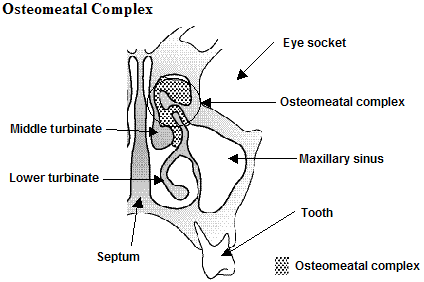Maxillary Sinuses
The maxillary sinuses are the largest sinuses. They are located in the midface and are bordered by the eye sockets, upper jaw and upper teeth. Present at birth, the maxillary sinuses go through growth spurts from birth to age 3 and again from age 7 to 12. They reach full size by the teenage years. An adult size maxillary sinus is large enough to hold about 3 teaspoons of water.
Mucus and air from the maxillary sinuses drain into the nose under the middle turbinate. The space beneath the middle turbinate, including the outflow tract for mucus and air from the maxillary sinus, is called the osteomeatal complex. Disease or blockage of mucus and air flow through the osteomeatal complex is a frequent cause of infection in the maxillary, ethmoid and frontal sinuses. Maxillary sinus pain is often felt in the upper teeth, behind the cheekbones and near the sides of the nose.

A serious but rare complication of maxillary sinusitis can occur when a bacterial infection within the sinus cavity spreads to the tissues surrounding the brain. This can result in meningitis, an inflammation of the membranes surrounding the brain. Pus can also penetrate the brain tissue resulting in a brain abscess.